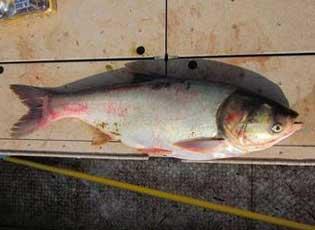Hypophthalmichthys molitrix (Valenciennes in Cuvier and Valenciennes, 1844) (ITIS)
Silver carp
Eastern Asia (NAS Database)
1973 (NAS Database)
Imported for aquaculture and for phytoplankton control (NAS Database)
Has the potential to cause enormous damage to native species because it feeds on plankton required by larval fish and native mussels. Is a potential competitor with adults of some native fishes, for instance, gizzard shad, that also rely on plankton for food (NAS Database)

Silver carp, adult
Photo by Lindsey Lewis; U.S. Fish and Wildlife
Find more images
Spotlights
Distribution / Maps / Survey Status
Federally Regulated
Videos
All Resources
Selected Resources
The section below contains highly relevant resources for this species, organized by source.
Council or Task Force
Partnership
Federal Government
International Government
State and Local Government
Academic
Professional
Integrated Taxonomic Information System. Hypophthalmichthys molitrix. [Accessed Sep 22, 2023].
Nonindigenous Aquatic Species Database. Fact Sheet - Silver Carp. USGS, Gainesville, FL. [Accessed Sep 22, 2023].
